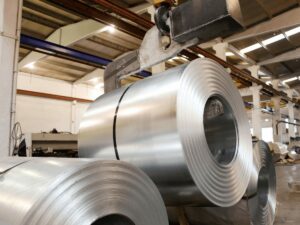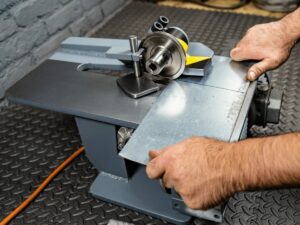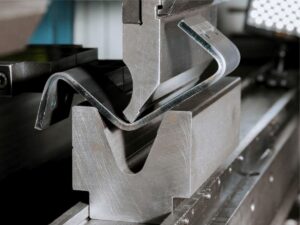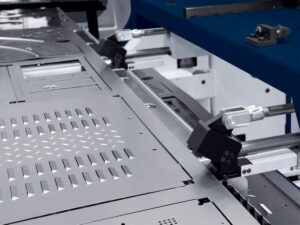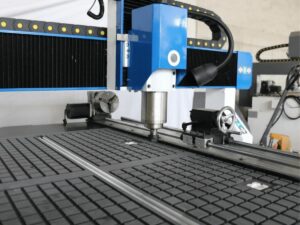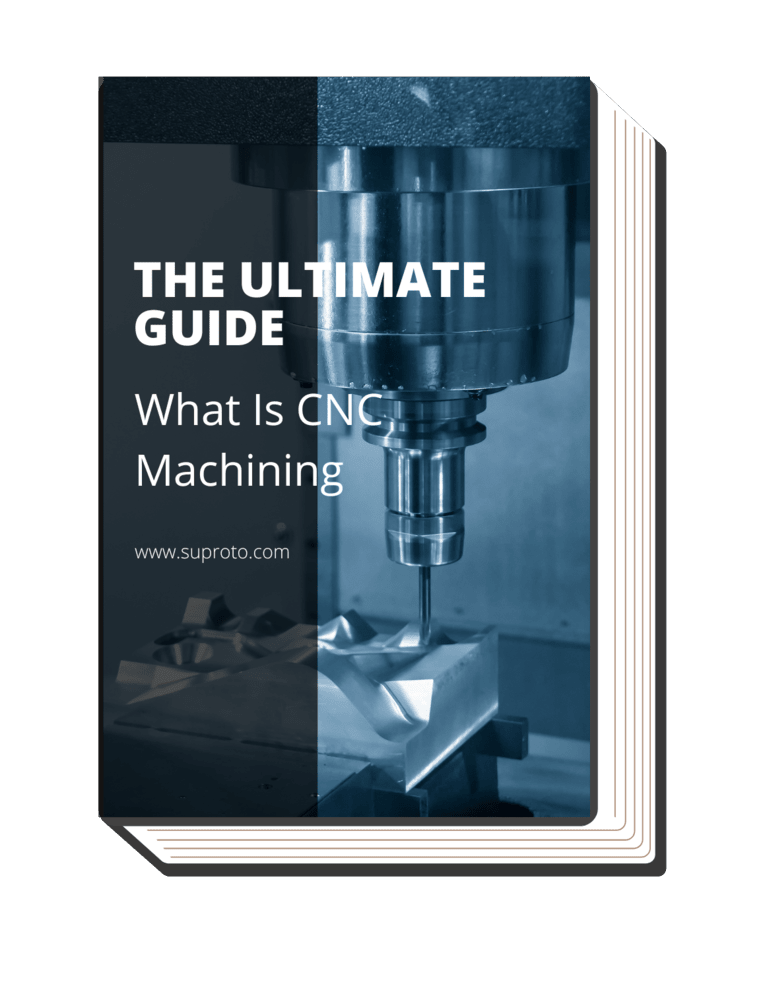1. Understanding Sheet Metal
Envision this – a futuristic robotic arm, with the elegance of a ballerina and the precision of a Swiss watch, meticulously bending a sheet of steel as if it was origami. That’s the marvel of modern sheet metal fabrication. On a serious note, sheet metal is indispensable in an array of industries, including aerospace, automotive, construction, and electronics.
These pliable metal heroes can be crafted from a variety of materials such as aluminum, brass, copper, low carbon steel, stainless steel, and tungsten, depending on the demands of strength, durability, and corrosion resistance. With advanced techniques such as laser cutting, CNC machining, and collaborative robots, the sheet metal fabrication market is slated to reach a whopping $17.2 billion by 2026.
2. Advantages of Sheet Metal Fabrication
In the ever-evolving world of manufacturing, sheet metal fabrication stands as a versatile and efficient method. Below are the advantages of sheet metal fabrication to explore:
Flexibility
With an array of fabrication techniques such as cutting, bending, and assembling at disposal, sheet metal fabrication is versatile. This means whether creating a simple bracket or an intricate machine component, sheet metal fabrication can bend itself to whims and fancies.
Strength and durability
The alchemy of shaping sheets without compromising the material’s integrity ensures that the end products are strong and durable. As I can see, this makes sheet metal products the go-to choice for industries that require rugged and long-lasting components.
Cost-effective
One of sheet metal fabrication’s golden feathers is its cost-effectiveness. Especially when it comes to large-scale production, the price per part plummets, making it an economical choice for both prototyping and production.
High precision
From my point of view, the use of cutting-edge technology like laser cutting ensures high precision in sheet metal fabrication. This is vital when creating components that need to fit together perfectly or when the aesthetics of the final product are paramount.
Customizability
The fact that sheet metal fabrication is highly customizable is akin to the cherry on top. This means even if the initial design doesn’t quite cut the mustard, modifications can be swiftly made without breaking a sweat. It is possible to carry out the design of the necessary parts and select the material through custom sheet metal fabrication.
Efficiency
Sheet metal fabrication is not just about being flexible and customizable but also about efficiency. With advanced machineries like laser cutters and press brakes, the fabrication process is streamlined and fast, ensuring timely delivery of products.
3. Common Materials Used in Sheet Metal Fabrication
Sheet metal fabrication involves shaping and assembling metal sheets to create various products and structures. These materials are essential for industries such as automotive, construction, and electronics. Below are the ff:
Steel
One of the most widely used materials in sheet metal fabrication, steel is loved for its strength. However, not all steel is created equal, with cold rolling steel being particularly popular due to its smooth surface and added strength.
Aluminum
I can say that aluminum is the metaphorical featherweight champion in the world of metals. With its lightweight nature combined with commendable strength, it is often used in the aerospace and automotive industries. A study says, aluminum is easily machined and can be relatively easily textured with grit blasting and chemical etching.
Stainless Steel
A variant of steel, stainless steel is resistant to rust and boasts a glossy finish. I have seen it extensively used in applications where both aesthetics and durability are vital. Stainless steel can be found gracing kitchen appliances, hospital equipment, and decorative structures.
Copper
At least 10,000 years ago, copper was first used, but since 1900, more than 95% of all copper has been mined and smelted. According to Science Direct, due to its excellent electrical conductivity and ductility, pure copper is primarily used in electrical applications. Not to mention, it also adds a touch of class to decorative items with its rich, red-orange hue.
4. The Process of Sheet Metal Fabrication
To make sense of the marvel that is sheet metal fabrication, let’s delve into the steps involved in this process. Here are some to explore:
Step#1 Design and Planning
I believe, before any piece of metal sees the light of day in a final product, everything starts with an idea—a seed sown in the fertile ground of design and planning. Here, engineers and designers use CAD software to make intricate blueprints, setting the stage for what’s to come. This includes steps defining the end product and addresses material selection and manufacturing constraints.
Step#2 Material Preparation
This is where the selection of the right metal sheet is tailored to the specifications and demands of the product. From steel and aluminum to brass and copper, the choices are vast. The thickness of the metal sheet is also critical, with thicker gauges suited for heavy-duty applications and thinner ones prized for their malleability
Step#3 Forming and Shaping
I can vouch the real magic begins in forming and shaping. The chosen metal sheet is subjected to a myriad of processes such as cutting, bending, and folding to transform it into the desired shape. This is where machines like press brakes take center stage, bending the sheet with finesse and precision.
Step#4 Joining and Assembly
As the puzzle pieces start coming together, it’s time for joining and assembly. Like a symphony of metal parts, each piece finds its place in this grand composition. Techniques like welding, riveting, and bolting are employed to ensure that the structure holds firm. If welding is involved, cleanliness is paramount as the final step awaits.
Step#5 Finishing and Surface Treatment
And finally, the pièce de résistance – the finishing touch. Here, the assembled parts are subjected to surface treatments like powder coating to not only make them look aesthetic but also to protect them from corrosion and enhance durability.
5. Common Tools and Techniques Used in Sheet Metal Fabrication
Having explored the wondrous journey of sheet metal fabrication, let’s arm ourselves with the tools and techniques that make this process possible. These are the brushes and chisels in the hands of the artists, the fabricators. Here are those:
Shears
Starting with the most fundamental, shears are like the mighty scissors of the metal world. They make quick and clean cuts without melting or burning the metal. This cost-effective method is ideal when complex cuts are not required.
Press Brakes
Press brakes are the gymnasts of the sheet metal fabrication world, bending and folding metal sheets into a plethora of shapes. I believe they’re responsible for the majority of the folds seen in metal components. An engineer well-acquainted with metal bending can create wonders with these machines.
Punching Machines
I can imagine a powerful metal fist punching through sheets – that’s what punching machines do. They are ideal for creating holes and are especially suited for large-scale production. These machines are quick and effective but require a separate tool for different cuts.
Welding Equipment
Welding is the glue that holds everything together. It’s an essential part of joining and assembly. The precision and skill involved in welding can make or break the integrity of the final product. As per Grand View Research, the global welding equipment market size was estimated at USD 18,831.6 million in 2022 and is expected to expand at a compounded annual growth rate (CAGR) of 5.0% from 2023 to 2030.
CNC Machines
Here, let’s talk about the magicians – CNC machines. These are the masters of precision, controlled by computer programs to perform extremely accurate cutting, bending, and forming. CNC machines are indispensable in the realm of sheet metal fabrication.
6. Applications of Sheet Metal Fabrication
The ability to mold sheet metal into complex shapes has made it an invaluable resource. Now, let’s take a journey into the realms where sheet metal fabrication plays a pivotal role. See the ff below:
Automotive industry
In the realm of the automotive industry, sheet metal fabrication is akin to a magician. Almost every part of an automobile has some element of sheet metal fabrication involved. From the body panels to engine components, the utilization is extensive.
Aerospace industry
Soaring through the skies, the aerospace industry is one where precision is paramount. Here, sheet metal fabrication takes a front seat in crafting various components like airframes, engine casings, and interior cabin structures. I have witnessed some companies rely on high-strength, lightweight sheet metals for their aircraft and spacecraft.
Construction industry
Building the skeletons of our cities, the construction industry employs sheet metal fabrication in a myriad of ways. Whether it’s roofing, HVAC systems, or structural frameworks, sheet metal proves to be both versatile and robust. For example, skyscrapers like the Burj Khalifa utilize sheet metal in their structural elements.
Electronics industry
With the ever-shrinking sizes of electronic devices, sheet metal fabrication steps in as the hero. It’s widely used for making casings, brackets, and other components in electronics. Apple’s Mac Pro, for instance, utilizes a stainless steel space frame, while many gaming consoles also have sheet metal components.
Medical industry
In the medical industry, sheet metal fabrication contributes significantly, from surgical tools to hospital beds and equipment casings. It ensures high levels of sanitation and durability. Companies like Suproto specialize in producing high-quality sheet metal components for medical applications.
Energy industry
Harnessing the power of the elements, the energy industry utilizes sheet metal fabrication for everything from wind turbines to solar panel frames. As a sustainability enthusiast myself, its applications in renewable energy sources are continually evolving, making way for a more sustainable future.
7. Challenges in Sheet Metal Fabrication
As with any art form, sheet metal fabrication comes with its own set of challenges. Let’s shed some light on these challenges and how they shape the path of fabrication. Refer to the data below:
Material limitations
Different materials have various properties, and not all are suited for specific applications. I can say, while aluminum is lightweight, it may not provide the same strength as steel. Selecting the right material is crucial, and sometimes compromises need to be made between strength, weight, and cost.
Design complexity
At Suproto, we believe that with great design comes great responsibility. Sometimes a design can be too complex to be manufactured efficiently or cost-effectively. The balance between a design’s intricacy and its manufacturability is a delicate one and requires extensive knowledge and experience.
Tooling costs
Sheet metal fabrication often requires specialized tools, and these can be expensive. For example, custom dies and molds can skyrocket costs, especially for short-run projects. Finding a balance between tooling costs and production needs is essential.
The table below provides insights into the considerations and factors related to tooling costs in sheet metal fabrication. Explore the impact of custom dies and molds, production volume, tooling materials, maintenance, and alternative solutions on managing tooling expenses. Discover how finding a balance between tooling costs and production needs is crucial for cost-effective sheet metal fabrication.
| Tooling Costs Considerations |
Description |
| Custom Dies and Molds |
Custom dies and molds are often necessary for specific sheet metal fabrication projects. These specialized tools are tailored to the required shapes and dimensions of the parts being produced. However, the cost of designing and manufacturing custom dies and molds can be significant, particularly for short-run projects where the expenses may not be spread across a large production volume. Balancing the need for custom tooling with the project’s budget is crucial to managing tooling costs effectively. |
| Production Volume |
The production volume plays a crucial role in tooling costs. For large-scale production runs, the expenses associated with custom tooling can be justified as the tooling costs are distributed over a greater number of parts. However, for short-run projects or prototypes, the tooling costs per unit may be significantly higher, impacting the overall cost-effectiveness of the fabrication process. Analyzing the production volume and assessing the feasibility of tooling costs based on the projected demand is important in cost management. |
| Tooling Materials and Complexity |
The choice of tooling materials and the complexity of the required tools can influence tooling costs. Certain materials, such as high-grade steels or specialized alloys, may be more expensive to procure and machine. Additionally, the complexity of the parts being fabricated can impact the complexity and intricacy of the tooling required, which can add to the overall tooling costs. Assessing the material requirements and the level of complexity involved in tooling is essential for estimating and managing costs effectively. |
| Tooling Maintenance and Lifespan |
Tooling costs also include maintenance and lifespan considerations. Regular maintenance and proper care of the tools can extend their lifespan and reduce the need for frequent replacements or repairs. Effective tooling management practices, such as preventative maintenance and timely repairs, can help minimize unexpected expenses and optimize the longevity of the tools, thereby positively impacting the overall cost-effectiveness of the fabrication process. |
| Alternative Tooling Solutions |
Exploring alternative tooling solutions, such as modular tooling systems or shared tooling arrangements, can be considered to reduce tooling costs. These options offer flexibility, cost-sharing benefits, and the ability to accommodate a range of fabrication projects without the need for extensive custom tooling. Assessing the suitability of alternative tooling solutions and their cost-effectiveness is essential in managing tooling costs efficiently. |
Skill requirements
The hands that mold the metal need to be skilled and experienced. Sheet metal fabrication is an art form, and like any art, it requires a level of mastery that only comes with experience. Skilled labor is a valuable asset and sometimes hard to come by.
Quality control
Ensuring that the final product meets the desired specifications and is free of defects is paramount. However, maintaining consistent quality control can be challenging, especially for complex or large-scale projects. The use of advanced technologies and rigorous testing procedures can aid in achieving high-quality standards.
8. 6 Tips for Choosing a Sheet Metal Fabrication Service Provider
Selecting the right service provider is crucial to choosing the right kind of metal; it can make or break a venture. Knowing the factors that distinguish an exceptional service provider from a mediocre one is crucial. Let’s dive into some essential tips for making an informed choice.
#1 Experience and expertise
I trust the adage “experience is the best teacher” rings true in the domain of sheet metal fabrication. The experience of the service provider matters significantly, as an established provider is likely to have honed its techniques and efficiency. Additionally, their knowledge of dealing with various materials and designs can be invaluable.
#2 Capabilities and equipment
As the sheet metal fabrication industry evolves, a company that keeps pace with cutting-edge technology is often a step ahead. It is essential to evaluate the range of services a fabricator can offer and the equipment they employ. Modern automation solutions in fabrication can be crucial to maintaining quality
#3 Quality control measures
As a veteran in the business, quality is the backbone of any project. Assessing a service provider’s quality control program is essential. Skilled labor, certified welders, and a robust quality control program are the pillars that can prevent project issues and delays. Ascertain the certifications and quality checks that the company employs to ensure that the project sails smoothly through the tempestuous seas.
#4 Customization options
A nimble craftsman can mold sheet metal to dance to his tunes. Likewise, a service provider that offers customization options is like a pot of gold at the end of the rainbow. Whether it’s a tweak in design or a specific material preference, having the option to customize can save time and resources.
#5 Pricing and lead times
While cost should not be the sole determining factor, it’s an important one. Evaluate the pricing structure and ensure it aligns with the budget without compromising on quality. Understanding the lead times and ensuring they sync with the project timelines is vital to avoid any delays. An efficient service provider will have streamlined processes that allow for competitive pricing and timely delivery.
#6 Customer reviews and references
Last but not least, word of mouth still holds power in this digital age. Scour through customer reviews and ask for references. Positive feedback and happy clients are usually good indicators of reliability and professionalism. Suproto, a known player on the market, has a trail of positive customer feedback, which can be a testament to our credibility.
Dive Deeper Into Our Resources
Looking for more diverse product options? Browse through our handpicked selections:
Still haven’t found what you’re looking for? Don’t hesitate to contact us. We’re available to assist and guide you.
Conclusion
We have seen sheet metal fabrication as a sophisticated craft that encompasses a gamut of processes, using sheet metal to construct machines and structures. In this age of digital disruption, the business landscape in the fabrication sector is witnessing unprecedented changes. With that in mind, businesses must prepare to ride the waves of this dynamic industry.
Reach out to us with any questions or insights regarding the sheet metal fabrication domain. Our team of experts is here to provide the knowledge and support every business needs to thrive. Contact us today and let’s forge a partnership that is as strong and versatile as the metals we mold.

